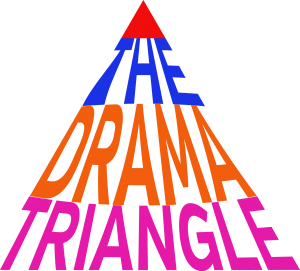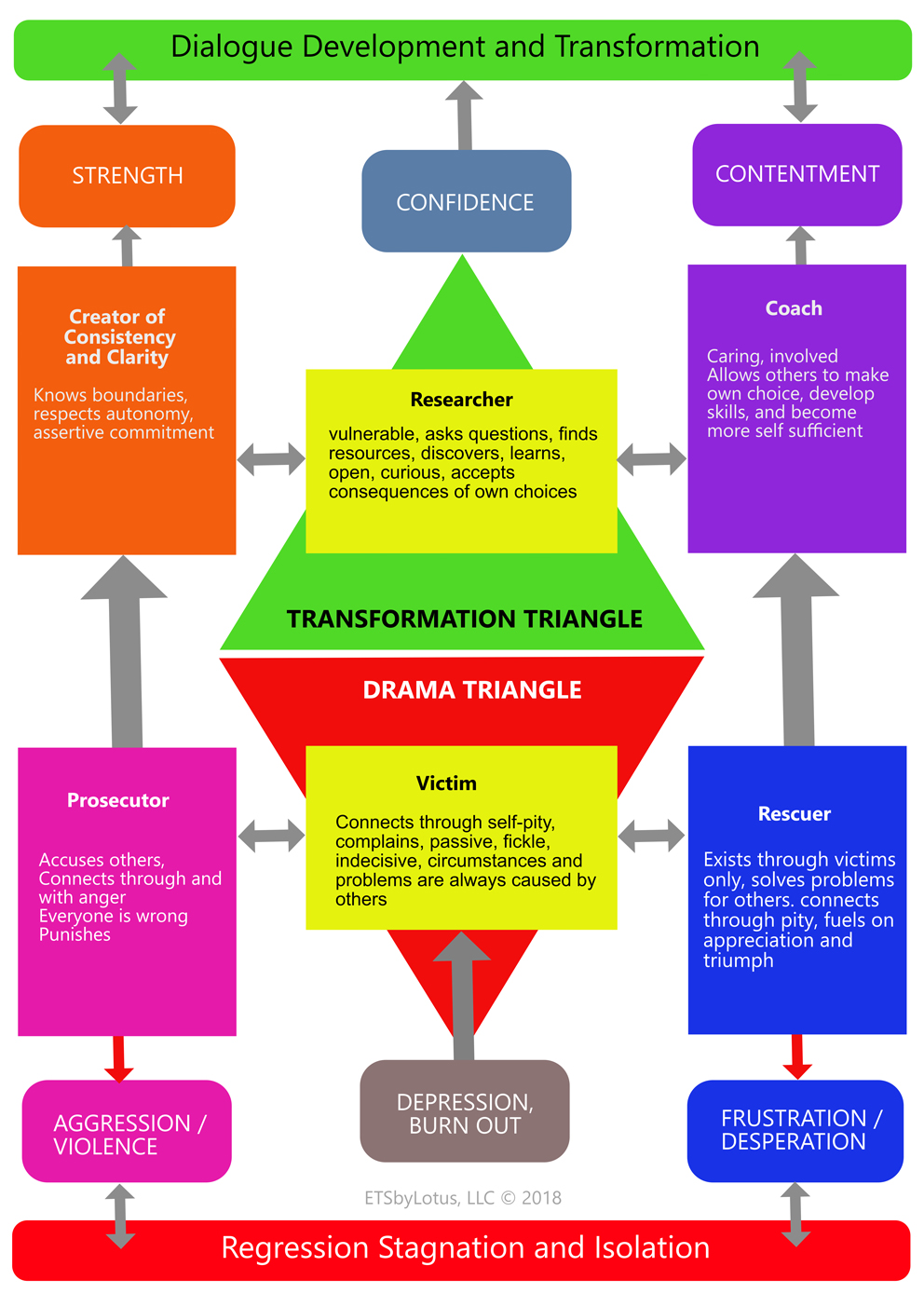In Part 2 of this article, we look at how to help clients break through the Drama Triangle and get on the road to healthier relationships.
The Drama Triangle, which was developed by Stephen Karpman, is a practical interpretation of Transactional Analysis (TA), which was introduced by Eric Berne in the middle of the 20th Century. TA is defined as: “a system of popular psychology based on the idea that one’s behavior and social relationships reflect an interchange between parental (critical and nurturing), adult (rational), and childlike (intuitive and dependent) aspects of personality established early in life.”
First, let’s revisit a breakdown of the roles* in the Drama Triangle, which were explored in more detail and with examples in Part 1 of this article, which appeared in the June issue of Transformation Coaching Magazine.
The Victim: “Poor me!” The victim feels victimized, oppressed, helpless, hopeless, powerless, ashamed, and seems unable to make decisions, solve problems, take pleasure in life or achieve insight. The victim, if not being persecuted, will seek out a Persecutor and also a rescuer, who will save the day but also perpetuate the victim’s negative feelings.
The Rescuer: “Let me help you.” A classic enabler, the rescuer feels guilty if he/she doesn’t go to the rescue. Yet this rescuing has negative effects: It keeps the victim dependent and gives the victim permission to fail. The rewards derived from this rescue role are that the focus is taken off of the rescuer. This rescue role is also very pivotal because a rescuer’s primary interest is actually an avoidance of personal problems disguised as concern for the victim’s needs.
The Prosecutor: (a.k.a., Persecutor or Villain) “It’s all your fault.” The prosecutor is controlling, blaming, critical, oppressive, angry, authoritative, rigid and superior.
*Source: Wikipedia, “Karpman Drama Triangle.”
Most of us are neurologically programmed to play all three roles. Moreover, the Drama Triangle is not static; it is in motion. The players move quickly and reactively from one role to another; in other words, they swap between roles.
It is important to recognize the signs and different behaviors in the roles. Your energy levels as a coach are impacted by the cycle of the Drama Triangle, and clients stuck in the cycle show symptoms of burnout and depression. When those involved acknowledge and recognize that the root of the drama cycle is fear, that’s when they can start stepping out of the problems and making changes.
Recognize the Signs
What the rescuer doesn’t recognize is that, by assisting and rescuing the victim, behaviors become stagnate. A rescuer tries to protect the victim from more pain, and, as a result, prevents that person from learning to manage the pain. In the position of the rescuer, an individual tries hard to help the victim, while the victim sits back and accepts criticism. Victims reject ownership of their problems. As long as the rescuers rescue, the victims don’t face their own problems. In other words, there’s no transformation or change if you continue to rescue the victim. It’s understandable that someone wants to help when he or she care about someone, but realize that only that person is the one who’s working hard—not the victim.
You hear the rescuer make statements such as:
• “As long as I can influence him, there’s hope for a change.”
• “If I don’t help her, then the situation will get out of control”
• “If I don’t help, he will break down.”
• “If I stop my assistance, she will be unhappy”
Let’s go back to the example of V.J. and O.J. from Part 1 of this article. V.J. is a man who cannot have healthy relationships with women because he is trapped in Drama Triangle with is mother O.J. and his partner at any given time:
V.J. starts a relationship because he desires sex and a roof over his head while he is playing the role of entrepreneur (or working a job as he calls it). Unsuccessful phone calls, meetings, traveling to foreign countries, and then add a frustrated partner who’s suffering from this lifestyle. During the honeymoon phase it’s exciting. New imprints, exciting stories, but after a while it turns into a burden and V.J.’s success rates are questioned. Meanwhile, V.J.’s mother, O.J., leans on him because her social security check is insufficient to fund her alcoholic habits. O.J. reminds VG that she gave birth to him, so he owes her. V.J. either moves her in or gets her an apartment close enough to maintain the tightknit relationship…
V.J.’s partners and V.J. are enablers. O.J and V.J. don’t have to change because V.J. will always come to O.J.’s rescue, and V.J. handpicks women whom he can rescue to make him feel good about himself. There are no profound consequences for their behaviors. V.J. believes in the illusion he can always rescue O.J. V. J.’s partner accepts his sorry when he blows up, and, if not, he’ll find another person to play the role. If V.J. became aware that he believed in an illusion, and that he would never be able to take responsibility for O.J.’ s happiness, then O.J. may have a chance. If V.J. accepted his fears of rejection, he could work on his fear and stay with one partner instead of jumping ship and using O.J. or his kids from a previous marriage as an excuse to avoid working on himself.
Both O.J. and V.J. need to learn to stand on their own feet, rather than finding a crutch or excuses for misfortune and failure in their lives.
Stop Enabling
Not matter how much someone attempts to rescue, it is the victim who must decide to make a transformation. We can encourage the victim to accept ownership of the problem and support the fact that there is a problem, but the rescuer must step out of the Drama Triangle, too.
By maintaining the situation and the role, the victim doesn’t have to face fears and pain, but the victim must take ownership of this pain and act. As coaches, we can encourage the victim to manage the pain rather than protect that individual from the pain.
Under normal circumstances, a person experiencing pain and discomfort actively tries to change instead of remaining passive. There’s a control issue in this situation, rather than anger, that moves the person: “I have had it, and I am going to make a change”.
When someone stops playing the role of rescuer, he must be prepared for rejections, protests and obstructions. The prosecutor will fight and obstruct any change and turn the tables trying to guilt trip us, making statements such as:
• “You can’t do this to me.”
• “You owe me.”
• “I thought I could trust you.”
• “Only you can make me happy.”
• “I thought you were my friend.”
The prosecutor will attempt to make the rescuer feel guilty and try to change his mind and stance, making him doubt if he is making the right judgment call. When a victim/prosecutor deflects, he is avoiding the discussion about the actual issues. Victims usually don’t assume this role on purpose; it happens when they are unaware of their own abilities, strengths and options.
*Source: Wikipedia, “Karpman Drama Triangle.”
Break Through the Drama Triangle.
In the Drama Triangle, there is not an authentic connection between the victim and the rescuer. Both lack transparency and honesty about their true feelings. At this point, an open and honest conversation—facilitated by a coach—can reveal the patterns and roles in the Drama Triangle.
It’s a dance where both victim and rescuer keep each other captive until a breakthrough happens. Sometimes the victim transforms the rescuer and vice versa. In this process, coaches can facilitate a dialog between both parties and provide clues as to how to start a new conversation.
The real connection starts when people connect with how they truly feel. The rescuer must admit he/she is tired of rescuing and than set boundaries. The victim must admit he/she has not accepted full ownership of the problem. Emotional transparency implies that both parties need to learn to discuss their needs and deepest feelings—feelings such as abuse, pain, shame, pain, sadness, fear, disappointment and anger.
The most difficult admission is: “I need you.” When two people express they are both in an equally vulnerable position, a true bond is made possible. Such a conversation and connection can only take place if they allow each other the space and opportunity to speak their mind and heart. When there is a set time and place to discuss such a matter both parties must be emotional available. Trust yourself as a coach and you can create a that safe environment for dialogue.
Lotus Josiah Seng, MA., Ph.D., is a Certified Change Management Professional; Certified and Associated IWCA Master Coach; Master Expert NLP; Certified Expert Lean Management Practitioner; and CSSB. She is the owner of ETSbyLotus,LLC, a coaching, mediation and consulting firm with offices in Washington, D.C., Maryland, Virginia and New York.Currently, five coaches are affiliated with the firm. ETS’ team has more than 25 years of accumulative experience as licensed meditators and certified relationship, cognitive behavior therapy, NLP and change management coaching practitioners. ETS’ team consists of C-suite executives who serve as mentors for peers in several industries. The ETS team works as coaches and mediators with companies, couples, siblings, families and executives to foster personal growth,improve relationships, and foster all aspects of healthy and effective communication. ETS’ objective is to inspire leaders and influencers to discover their uncovered potential. Lotus’ vision stems from her solution-focused coaching philosophy.She created the Map. Your. Future.© interactive game and methodology using neuroscience to tap clients’ unique strengths. Her 17- and 18-steps plan results in a creative visual map based on critical thinking and an analytical process towards (shared) goals, missions and objectives. For more information email: lotus@etsbylotus.com or follow Lotus on Twitter: EtsbyLotus or Instagram: Sheswalkingwithwings.


